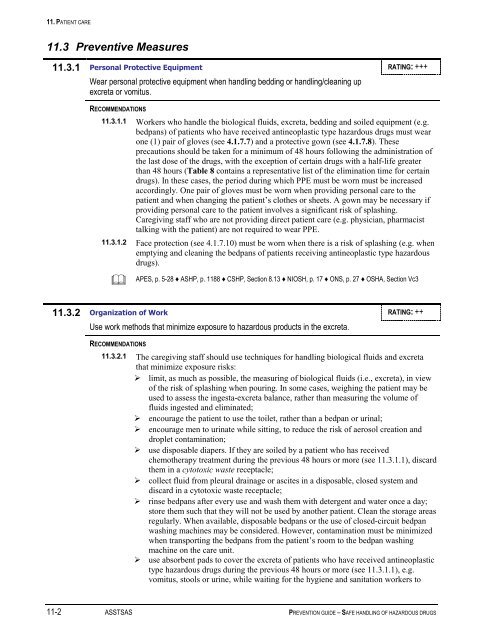Prevention Guide - Safe Handling of Hazardous Drugs - Irsst
Prevention Guide - Safe Handling of Hazardous Drugs - Irsst
Prevention Guide - Safe Handling of Hazardous Drugs - Irsst
Create successful ePaper yourself
Turn your PDF publications into a flip-book with our unique Google optimized e-Paper software.
11. PATIENT CARE<br />
11.3 Preventive Measures<br />
11.3.1 Personal Protective Equipment RATING: +++<br />
Wear personal protective equipment when handling bedding or handling/cleaning up<br />
excreta or vomitus.<br />
RECOMMENDATIONS<br />
11.3.1.1 Workers who handle the biological fluids, excreta, bedding and soiled equipment (e.g.<br />
bedpans) <strong>of</strong> patients who have received antineoplastic type hazardous drugs must wear<br />
one (1) pair <strong>of</strong> gloves (see 4.1.7.7) and a protective gown (see 4.1.7.8). These<br />
precautions should be taken for a minimum <strong>of</strong> 48 hours following the administration <strong>of</strong><br />
the last dose <strong>of</strong> the drugs, with the exception <strong>of</strong> certain drugs with a half-life greater<br />
than 48 hours (Table 8 contains a representative list <strong>of</strong> the elimination time for certain<br />
drugs). In these cases, the period during which PPE must be worn must be increased<br />
accordingly. One pair <strong>of</strong> gloves must be worn when providing personal care to the<br />
patient and when changing the patient’s clothes or sheets. A gown may be necessary if<br />
providing personal care to the patient involves a significant risk <strong>of</strong> splashing.<br />
Caregiving staff who are not providing direct patient care (e.g. physician, pharmacist<br />
talking with the patient) are not required to wear PPE.<br />
11.3.1.2 Face protection (see 4.1.7.10) must be worn when there is a risk <strong>of</strong> splashing (e.g. when<br />
emptying and cleaning the bedpans <strong>of</strong> patients receiving antineoplastic type hazardous<br />
drugs).<br />
<br />
APES, p. 5-28 ♦ ASHP, p. 1188 ♦ CSHP, Section 8.13 ♦ NIOSH, p. 17 ♦ ONS, p. 27 ♦ OSHA, Section Vc3<br />
11.3.2 Organization <strong>of</strong> Work RATING: ++<br />
Use work methods that minimize exposure to hazardous products in the excreta.<br />
RECOMMENDATIONS<br />
11.3.2.1 The caregiving staff should use techniques for handling biological fluids and excreta<br />
that minimize exposure risks:<br />
‣ limit, as much as possible, the measuring <strong>of</strong> biological fluids (i.e., excreta), in view<br />
<strong>of</strong> the risk <strong>of</strong> splashing when pouring. In some cases, weighing the patient may be<br />
used to assess the ingesta-excreta balance, rather than measuring the volume <strong>of</strong><br />
fluids ingested and eliminated;<br />
‣ encourage the patient to use the toilet, rather than a bedpan or urinal;<br />
‣ encourage men to urinate while sitting, to reduce the risk <strong>of</strong> aerosol creation and<br />
droplet contamination;<br />
‣ use disposable diapers. If they are soiled by a patient who has received<br />
chemotherapy treatment during the previous 48 hours or more (see 11.3.1.1), discard<br />
them in a cytotoxic waste receptacle;<br />
‣ collect fluid from pleural drainage or ascites in a disposable, closed system and<br />
discard in a cytotoxic waste receptacle;<br />
‣ rinse bedpans after every use and wash them with detergent and water once a day;<br />
store them such that they will not be used by another patient. Clean the storage areas<br />
regularly. When available, disposable bedpans or the use <strong>of</strong> closed-circuit bedpan<br />
washing machines may be considered. However, contamination must be minimized<br />
when transporting the bedpans from the patient’s room to the bedpan washing<br />
machine on the care unit.<br />
‣ use absorbent pads to cover the excreta <strong>of</strong> patients who have received antineoplastic<br />
type hazardous drugs during the previous 48 hours or more (see 11.3.1.1), e.g.<br />
vomitus, stools or urine, while waiting for the hygiene and sanitation workers to<br />
11-2 ASSTSAS PREVENTION GUIDE – SAFE HANDLING OF HAZARDOUS DRUGS

















